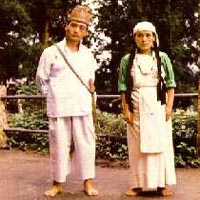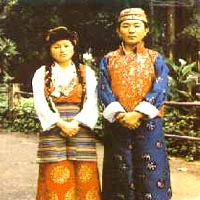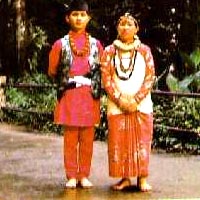| Destinations
|
|||||||||
Sikkim's population is predominated by those of Nepalese origin. They speak Nepali (Gorkhali) and are mostly Hindus. The Bhutias, Lepchas and Limbus are significant minorities. They speak Tibeto-Burman dialects and practice Mahayana Buddhism with large doses of the pre-Buddhist Bon religion. Since 1985, migrants from the other states of India have increased the Hindu population, while a small number of Christians and Muslims are also there. Different communities intermingle freely in Sikkim, and are seemingly inseparable to the visitor.
The Bhutias were responsible for introducing Buddhism to this community. Christianity is also practised by some. |
More about Sikkim • An Overview • Geography • History • Economy • Festivals • Off the Beaten Track • Wild Life • Adventure • Monastery Magic • Gangtok • Tourist Information • Accommodation • Getting There • Climate • FAQ
Travelogues
Trekking
| ||||||||
Bhutias
In the inner dry valleys of Northen Sikkim, where Bhutias are the major inhabitants, they are known as the Lachenpas and Lachungpas. Conditions here are extremely severe and the valleys here are separated from each other by almost impassable high mountains. The main settlement is at Lanchung and the principal summer pastures are Mome, Samdong and Yumthang. The traditional dress of the men is known as the Bakhu, which is a loose cloak type garment with full sleeves. The ladies wear a silken Honju which is a full sleeve blouse with a loose gown type garment worn over it. The womenfolk are very fond of heavy jewellery made of pure gold. The largest settlement of the Bhutias in Sikkim is Gangtok, with a population of over 30,000. Other large settlements are Singtam, Rongphu, Jorthang, Nayabazar, Mangan, Gyalshin, and Namchi.
Nepalese The traditional male dress consists of a long double breasted garment flowing below the waist and a trouser known as Daura Suruwal. The women wear a double-breasted garment with strings to tie on both sides at four different places. This is shorter than the Daura and is known as Chow Bandi Choli. They also wear a shawl known as Majetro. The Khukri which has become a symbol of the Nepali (Gurkha) culture, is a sharp edged, angled, heavy weapon carried in a wooden or leather scabbard known as Daab. Compiled by Romola Butalia
|
|||||||||
Editor: Romola Butalia (c) India Travelogue. All rights reserved. |
|||||||||
 Lepchas
Lepchas
 These are the people of Tibetan origin. They migrated to Sikkim somewhere after the fifteenth century. The Bhutias speak Sikkimese. Bhutia villages are as large as Lepcha settlements. A Bhutia house called Khin and is usually rectangular in shape.
These are the people of Tibetan origin. They migrated to Sikkim somewhere after the fifteenth century. The Bhutias speak Sikkimese. Bhutia villages are as large as Lepcha settlements. A Bhutia house called Khin and is usually rectangular in shape.
 The Nepalese were the last entrants and appeared on the Sikkim scene much after the Lepchas and Bhutias. They migrated in large numbers and soon became the dominant community. The Nepalese now constitute more than 80 % of the total population. The Nepali settlers introduced the terraced system of cultivation. Cardamom was an important cash crop introduced by the Nepalese. Except for the Sherpas and Tamangs who are Buddhists, the Nepalese are orthodox Hindus following the caste system.
Nepali is spoken and understood all over the state. This language is similar to Hindi and uses the Devangri script.
The Nepalese were the last entrants and appeared on the Sikkim scene much after the Lepchas and Bhutias. They migrated in large numbers and soon became the dominant community. The Nepalese now constitute more than 80 % of the total population. The Nepali settlers introduced the terraced system of cultivation. Cardamom was an important cash crop introduced by the Nepalese. Except for the Sherpas and Tamangs who are Buddhists, the Nepalese are orthodox Hindus following the caste system.
Nepali is spoken and understood all over the state. This language is similar to Hindi and uses the Devangri script.